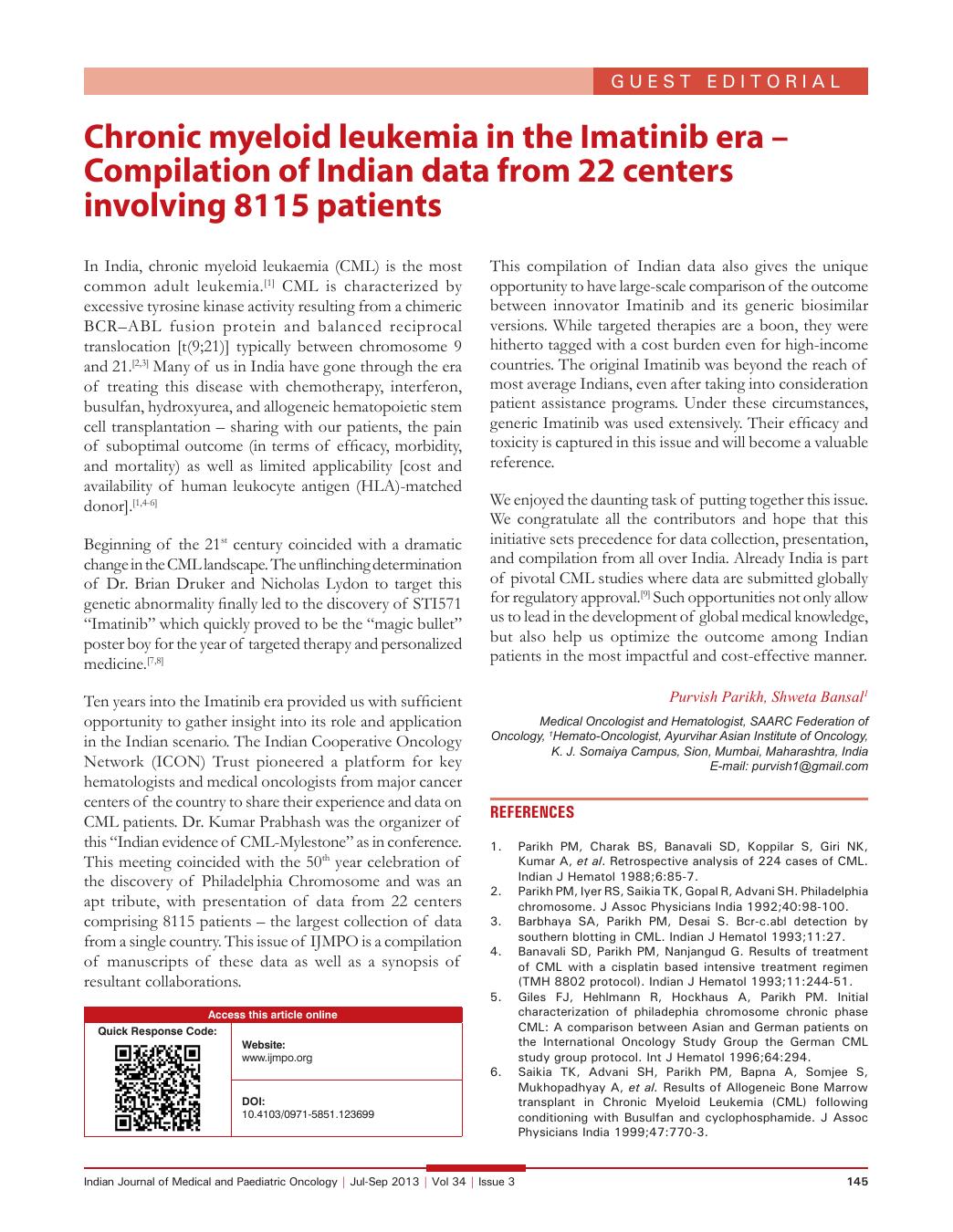Chronic myeloid leukemia in the Imatinib era - Compilation of Indian data from 22 centers involving 8115 patients
CC BY-NC-ND 4.0 · Indian J Med Paediatr Oncol 2013; 34(03): 145-146
DOI: DOI: 10.4103/0971-5851.123699

Publication History
Article published online:
19 July 2021
© 2013. Indian Society of Medical and Paediatric Oncology. This is an open access article published by Thieme under the terms of the Creative Commons Attribution-NonDerivative-NonCommercial-License, permitting copying and reproduction so long as the original work is given appropriate credit. Contents may not be used for commercial purposes, or adapted, remixed, transformed or built upon. (https://creativecommons.org/licenses/by-nc-nd/4.0/.)
Thieme Medical and Scientific Publishers Pvt. Ltd.
A-12, 2nd Floor, Sector 2, Noida-201301 UP, India
In India, chronic myeloid leukaemia (CML) is the most common adult leukemia.[1] CML is characterized by excessive tyrosine kinase activity resulting from a chimeric BCR–ABL fusion protein and balanced reciprocal translocation [t(9;21)] typically between chromosome 9 and 21.[2,3] Many of us in India have gone through the era of treating this disease with chemotherapy, interferon, busulfan, hydroxyurea, and allogeneic hematopoietic stem cell transplantation – sharing with our patients, the pain of suboptimal outcome (in terms of efficacy, morbidity, and mortality) as well as limited applicability [cost and availability of human leukocyte antigen (HLA)-matched donor].[1,4,5,6]
Beginning of the 21st century coincided with a dramatic change in the CML landscape. The unflinching determination of Dr. Brian Druker and Nicholas Lydon to target this genetic abnormality finally led to the discovery of STI571 “Imatinib” which quickly proved to be the “magic bullet” poster boy for the year of targeted therapy and personalized medicine.[7,8]
Ten years into the Imatinib era provided us with sufficient opportunity to gather insight into its role and application in the Indian scenario. The Indian Cooperative Oncology Network (ICON) Trust pioneered a platform for key hematologists and medical oncologists from major cancer centers of the country to share their experience and data on CML patients. Dr. Kumar Prabhash was the organizer of this “Indian evidence of CML-Mylestone” as in conference. This meeting coincided with the 50th year celebration of the discovery of Philadelphia Chromosome and was an apt tribute, with presentation of data from 22 centers comprising 8115 patients – the largest collection of data from a single country. This issue of IJMPO is a compilation of manuscripts of these data as well as a synopsis of resultant collaborations.
This compilation of Indian data also gives the unique opportunity to have large-scale comparison of the outcome between innovator Imatinib and its generic biosimilar versions. While targeted therapies are a boon, they were hitherto tagged with a cost burden even for high-income countries. The original Imatinib was beyond the reach of most average Indians, even after taking into consideration patient assistance programs. Under these circumstances, generic Imatinib was used extensively. Their efficacy and toxicity is captured in this issue and will become a valuable reference.
We enjoyed the daunting task of putting together this issue. We congratulate all the contributors and hope that this initiative sets precedence for data collection, presentation, and compilation from all over India. Already India is part of pivotal CML studies where data are submitted globally for regulatory approval.[9] Such opportunities not only allow us to lead in the development of global medical knowledge, but also help us optimize the outcome among Indian patients in the most impactful and cost-effective manner.


 PDF
PDF  Views
Views  Share
Share

